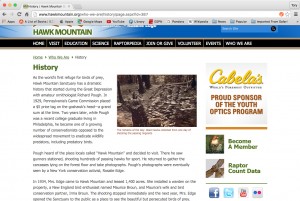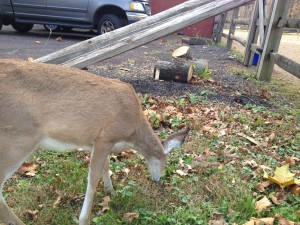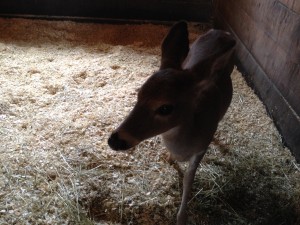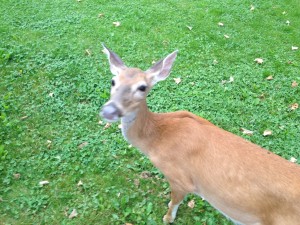On our trip to Hawk Mountain Sanctuary I noticed a particular side of Nature, the center seemed to want its visitor to experience. The sanctuary wanted to immerse us I in Nature and let us observe some of the best that nature can offer.
Before going to Hawk Mountain we read a passage from Silent Spring, that discussed the harmful impacts of pesticides like DDT on animals besides insects, especially birds. These impacts were the result of human negligence toward the environment and brought to center stage by Rachel Carson. Similarly, Hawk Mountain Sanctuary was the result of a similar motivation by an environmentally concerned citizen. This citizen was the Sanctuaries founder, Rosalie Edge. Edge decided to purchase the 1400 acre site after discovering the thousands of hawks and other birds being shot from the sky by hunters seeking bounty or even simply for game. Carson even mentions Hawk Mountain in her book and acknowledges the significance of the work done by those who observed and tracked birds there on the site. This part of what people are attracts people to Hawk Mountain now, rather than hunting birds themselves they are there to watch them.
When I was on top of the mountain I found the scene to be much more lively than I anticipated. There were a group of ‘serious observers’ with scopes set up on tripods keeping an eye for birds. There was also a number of other employees from the Sanctuary giving us a background of Hawk Mountain and offer their own binoculars so that we might get a better view ourselves, the more casual observers.
The observers would shout out when they saw a bird in the distance, so that even the casual observers, could get a glimpse and the other trackers could I.D. the hawk. The moment that struck me the most was when one of them spotted a rare hawk, a Goshawk. Every one of the spotters stopped and went silent to watch this lone hawk glide across the sky. This is why they did it, standing out in the cold on a Saturday in late November, to get a chance to see a part of nature they find truly beautiful. This is what nature should be to those who work and visit Hawk Mountain Sanctuary.
…

Funny that when doing research on Hawk Mountain the ad next to a picture of dead hawks is for Cabela’s.
Cabela’s obviously carried a lot different vibes than were found at Hawk Mountain. At Cabela’s it seems that nature is what man is of master of, Nature is conquered rather than something that we can observe or be a part of. To the average Cabela’s customer, it was sort of like they were selling you merchandise to help you on this quest and promoting man as the ultimate predator.
It wouldn’t be hard to create a profile of the average Cabela’s costumer; he’s probably a white male, middle-aged, probably has a wife and kids and can afford to shop for ‘competitively priced’ outdoors/hunting gear and have plenty of room to through whatever he buys in the bed of his pick-up. But Cabela’s wants this family man to bring in his family. There are very clearly distinct sections the store. While dad shops for a new gun or fishing rod, mom can take the kids to see the fish in Aquarium or the Deer County or go shopping for clothes and home-goods. Cabela’s is more of an experience than a place to go shopping. It’s why the first thing you see when you walk in is a Mountain of taxidermy. They are selling this experience and the guns, clothes, bait, furniture and food you buy are your souvenirs.
The displays themselves were rather impressive, especially the mountain. The display offered a few types of information. One was a touchscreen display, that offered a short description of the animals on display, showed a short video clip that creature in the wild and for some let you play that animals call through a speaker disguised as a rock.
The other information, visible on most of the taxidermy in the store, was the animals name and also the date it ‘taken’ and by whom. This was slightly more disarming, cause it was a reminder that everything on the hill was once a living animal now the center of a display as a trophy. This idea that nature was out there to be taken was one very clearly present in the store.
As with mentioned the mountain display, the Deer Country exhibit also displayed certain information. The hall included, I’m guessing, about 300 or so “trophy bucks” from across North America and the more prominent ones mounted on the walls with an article featuring the hunter and the bucks’ statistics. The stats, of course, were the point value assigned to the buck based on the B&C (Boone and Crockett Club) score. The scores are based on criteria like number of points on the antlers, the length of the spread and the length of points. According to the B&C website a typical record buck for Whitetails would rank somewhere in the 220 range. And though this room was seemed to highlight the hunt and glorify those who took these record bucks, it seems like it might not have been all about bagging the biggest buck but perhaps there was some conservationist promotion as well. On the way out of Buck Country was a sign overhead that read; “Ensure the beauty of the Outdoors – Support Wildlife Conservation”. This is arguably the most important sign in the store, but also probably the most widely ignored. Because I think the majority of people going to the store are not likely there to buy a gun to help contribute to conservationist efforts by hunting for the sake of population control.
There was another good quote I got out of the trip, taken from front of the biography Rosalie Edge, Rosalie Edge: Hawk of Mercy, found in the visitor center. The quote is actually the second subtitle of the book, ‘The activist who saved nature from the conservationists’. I think, in this case, the conservationists were the ones shooting hawks out of the sky about 80 years ago. These conservationists then, might have a lot in common with those leaving the Deer Country in Cabela’s, taking hawks or deer in the name of conservation or population control.




